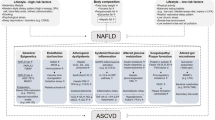Abstract
Purpose
The purpose of the present study was to examine the association of insulin resistance and inflammation with nonalcoholic fatty liver disease (NAFLD) in non-obese adults without metabolic syndrome components.
Methods
This was a cross-sectional study of 759 subjects aged 50 years and older. Diagnosis of NAFLD was based on sonographic evidence of fatty liver without significant alcohol consumption and another cause of chronic liver disease. Subjects without metabolic syndrome components were defined as having none of the following: high blood pressure (≥130/85 mmHg), elevated fasting glucose (≥100 mg/dl), hypertriglyceridemia (≥150 mg/dl), low high-density lipoprotein-cholesterol (men <40 mg/dl; women <50 mg/dl), and abdominal obesity measured by waist circumference ≥90 cm for men and ≥80 cm for women. The subjects were divided into quartile groups according to levels of high-sensitivity C-reactive protein (hs-CRP), homeostasis model assessment of insulin resistance (HOMA-IR), and uric acid. Odds ratios (ORs) were computed for each quartile relative to the lowest quartile group.
Results
After adjustment for age, sex, smoking status, regular exercise, hs-CRP, HOMA-IR, and uric acid, a significant association was found between NAFLD and higher levels of hs-CRP, HOMA-IR, and uric acid. After adjustment for age, sex, smoking status, regular exercise, hs-CRP, HOMA-IR, and uric acid, the Ors (95 % confidence interval) of NAFLD with the highest quartile of hs-CRP, HOMA-IR, and uric acid compared with the lowest quartile were 2.58 (1.03–6.50), 2.55 (1.08–6.05), and 5.15 (1.78–14.89), respectively.
Conclusions
Insulin resistance and inflammation are independently associated with NAFLD in non-obese adults without metabolic syndrome components.
Similar content being viewed by others
References
Lewis JR, Mohanty SR. Nonalcoholic fatty liver disease: a review and update. Dig Dis Sci 2010;55:560–578
Brunt EM. Histopathology of non-alcoholic fatty liver disease. Clin Liver Dis 2009;4:533–544
Angulo P. GI epidemiology: nonalcoholic fatty liver disease. Aliment Pharmacol Ther 2007;8:883–889
Angulo P. Nonalcoholic fatty liver disease. N Engl J Med 2002;16:1221–1231
Marchesini G, Bugianesi E, Forlani G, et al. Nonalcoholic fatty liver, steatohepatitis, and the metabolic syndrome. Hepatology 2003;4:917–923
Day CP, James OF. Steatohepatitis: a tale of two “hits”? Gastroenterology 1998;4:842–845
Grundy SM, Cleeman JI, Daniels SR, et al. Diagnosis and management of the metabolic syndrome: an American Heart Association/National Heart, Lung, and Blood Institute scientific statement. Circulation 2005;17:2735–2752
WHO Expert Consultation. Appropriate body-mass index for Asian populations and its implications for policy and intervention strategies. Lancet 2004;363:157–163
Neuschwander-Tetri BA, Caldwell SH. Nonalcoholic steatohepatitis: summary of an AASLD single topic conference. Hepatology 2003;5:1202–1219
Stevens LA, Coresh J, Greene T, Levey AS. Assessing kidney function—measured and estimated glomerular filtration rate. N Engl J Med 2006;354:2473–2483
Mathiesen UL, Franzen LE, Aselius H, et al. Increased liver echogenicity at ultrasound examination reflects degree of steatosis but not of fibrosis in asymptomatic patients with mild/moderate abnormalities of liver transaminases. Dig Liver Dis 2002;7:516–522
Park SH, Kim BI, Yun JW, et al. Insulin resistance and C-reactive protein as independent risk factors for non-alcoholic fatty liver disease in non-obese Asian men. J Gastroenterol Hepatol 2004;6:694–698
Singh RB, Niaz MA, Agarwal P, et al. Epidemiologic study of central obesity, insulin resistance and associated disturbances in the urban population of North India. Acta Cardiol 1995;50:215–225
Knight TM, Smith Z, Whittles A, et al. Insulin resistance, diabetes, and risk markers for ischaemic heart disease in Asian men and non-Asian in Bradford. Br Heart J 1992;5:343–350
Kao PC, Shiesh SC, Wu TJ. Serum C-reactive protein as a marker for wellness assessment. Ann Clin Lab Sci 2006;36:163–169
Promrat K, Lutchman G, Uwaifo GI, et al. A pilot study of pioglitazone treatment for nonalcoholic steatohepatitis. Hepatology 2004;1:188–196
Angulo P, Hui JM, Marchesini G, et al. The NAFLD fibrosis score: a noninvasive system that identifies liver fibrosis in patients with NAFLD. Hepatology 2007;4:846–854
Lee YJ, Lee HR, Lee JH, Shin YH, Shim JY. Association between serum uric acid and non-alcoholic fatty liver disease in Korean adults. Clin Chem Lab Med 2010;2:175–180
Nieto FJ, Iribarren C, Gross MD, Comstock GW, Cutler RG. Uric acid and serum antioxidant capacity: a reaction to atherosclerosis? Atherosclerosis 2000;148:131–139
Albano E, Mottaran E, Occhino G, Reale E, Vidali M. Review article: role of oxidative stress in the progression of non-alcoholic steatosis. Aliment Pharmacol Ther 2005;22:71–73
García-Ruiz I, Rodríguez-Juan C, Díaz-Sanjuan T, et al. Uric acid and anti-TNF antibody improve mitochondrial dysfunction in ob/ob mice. Hepatology 2006;44:581–591
Hayden MR, Tyagi SC. Uric acid: a new look at an old risk marker for cardiovascular disease, metabolic syndrome, and type 2 diabetes mellitus: the urate redox shuttle. Nutr Metab (Lond) 2004;1:10
Dawson J, Walters M. Uric acid and xanthine oxidase: future therapeutic targets in the prevention of cardiovascular disease? Br J Clin Pharmacol 2006;62:633–634
Patterson RA, Horsley ET, Leake DS. Prooxidant and antioxidant properties of human serum ultrafiltrates toward LDL: important role of uric acid. J Lipid Res 2003;44:512–521
Clark JM, Brancati FL, Diehl AM. Nonalcoholic fatty liver disease. Gastroenterology 2002;122:1649–1657
Li Z, Tuteja G, Schug J, Kaestner KH. Foxa1 and Foxa2 are essential for sexual dimorphism in liver cancer. Cell 2012;148:72–83
Tchernof A, Poehlman ET, Després JP. Body fat distribution, the menopause transition, and hormone replacement therapy. Diabetes Metab 2000;26:12–20
Hernaez R, Lazo M, Bonekamp S, et al. Diagnostic accuracy and reliability of ultrasonography for the detection of fatty liver: a meta-analysis. Hepatology 2011;54:1082–1090
Acknowledgements
This work was supported by Konkuk University in 2012.
Author information
Authors and Affiliations
Corresponding author
Rights and permissions
About this article
Cite this article
Kim, S., Choi, J. & Kim, M. Insulin resistance, inflammation, and nonalcoholic fatty liver disease in non-obese adults without metabolic syndrome components. Hepatol Int 7, 586–591 (2013). https://doi.org/10.1007/s12072-012-9412-1
Received:
Accepted:
Published:
Issue Date:
DOI: https://doi.org/10.1007/s12072-012-9412-1




